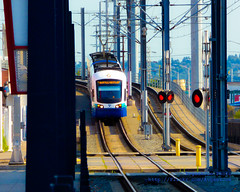Ridership Projection Uses and Abuses

Avgeek Joe/Flickr
University Link is coming in roughly one quarter. Expectations are high, not only for the revolution in travel time it will bring, but for the sheer volume of people expected to use the service. Sound Transit's draft 2016 Service Implementation Plan (p. 122) projects average weekday boardings of 34,600 this year jumping up to 51,800 in 2016 and 60,500 in 2017, the first full year of service. In subsequent years, it will grow to 65,600, 68,400, 70,800, and finally 79,800 in 2021, the year when more North Link stations will open.
This is as good a time as any to remind everyone that comparing actual riders to projected riders proves nothing about if the model was valid, nor does it convince any real voter that their vote was or wasn't justified.
The principal things that drive absolute ridership are the things that drive ridership systemwide: job growth, population growth, zoning decisions, fare levels, and the costs of driving (gas, tolls, parking). Transit consultants are not particularly qualified to predict many of these items, which will unfortunately overwhelm the technical merits of the line itself.
Moreover, as a rhetorical device appeals to projections utterly fail. Approximately zero people who voted for Central Link in the hopes for 40,000 a day would have changed their vote if the number was 32,000. Similarly, no light rail opponents suddenly become converts at 50,000. Within an order of magnitude, a project is useful and high-quality enough for a certain rough level of taxation or it isn't. Tweaks to the ridership models or tax micro-concessions don't change the politics.
What models are useful for is comparisons between projects, where the imprecisions from secular trends cancel each other out. Regrettably for pundits, there is no experiment where two versions of Seattle build different projects. At best, the region might build more than one of the possible projects, in which case network effects still complicate any assessment.
Going on about projections after they've completed their usefulness in alternatives analysis is a fun parlor game, but do not mistake it for thorough analysis or effective messaging.